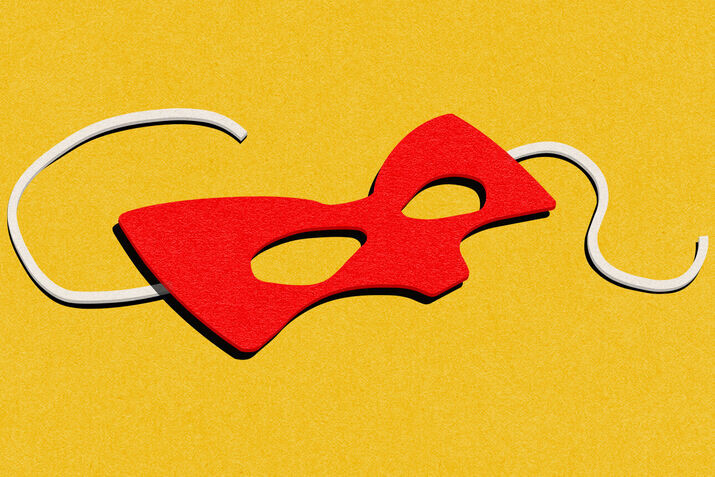Change Management: How to Avoid the Hero Trap
Many leaders of growing organizations bemoan employee resistance to change. But the reason most change efforts fail is that leaders suffer from the hero complex.
News
- Nexus Closes Eighth Fund at $700 Million for Early-Stage Bets in India and US
- Amazon to Pump $12.7 Billion into India’s AI and Cloud Expansion
- Anthropic Debuts Interviewer Tool to Understand How People Really Use AI
- IPL Tops Google’s Search List for 2025 as AI Breaks Into India’s Top 10
- TeamLease Names Suparna Mitra MD & CEO in Leadership Overhaul
- Apple Loses Top UI Designer as Alan Dye Joins Meta

The amount of change coming at leaders right now may feel unprecedented, given today’s political and technical landscape. But amid significant disruptions, such as artificial intelligence tools, deep-tech innovations, novel fintech platforms, and geopolitical shifts, an organization’s capacity to grow depends on its capacity to change constantly. Success also depends on your capability to lead that constant change. New processes need to be designed. New departments need to be formed. New products need to be developed. New markets need to be entered. Then, as you scale the organization, these new processes, departments, products, and markets need to be revised, restructured, and revisited: Wash, rinse, repeat. Within our exponentially volatile world, organizational growth is a constant challenge and, in turn, leading change is a critical leadership competency to answer this challenge. However, too many change efforts still fail.
Why is leading change so hard at times of growth? Many leaders bemoan employee resistance and hidden stakeholder agendas as key factors. While these can be significant factors, I don’t think blame can be pointed only at the employees and stakeholders. The truth is actually quite the opposite. In my experience working with companies trying to scale, the reason most change efforts fail is that leaders suffer from the hero complex.1 I define hero complex as a toxic mix of seeking overinflated credit (for the change) and experiencing extreme psychological ownership (of the change).
The complicating factor: Many aspects of leading change tend to bring out the hero complex — especially at times of company growth. Change puts leaders “onstage” to be lauded (or loathed) by those above (investors, senior management, partner organizations) as well as those below (employees, stakeholders). Being at the center of that stage also increases feelings of being the change’s star and, thus, owner. That can make leaders less likely to listen to others’ ideas for improvements to the change solution and/or more likely take any criticism of the change as a personal insult.
Being a hero for today’s change may also shut off a leader’s capacity to recognize a need for tomorrow’s change — hindering future growth and successful scaling, the very goal they seek.
Change Management Traps: Three Key Tips
So how can you steer clear of these traps? Consider these three pieces of advice, based on real-world companies’ experiences, that will help you fight the hero complex as you scale change for growth.
1. Don’t go solo with a solution: Build a coalition of experts.
In his book Leading Change, organizational change expert John Kotter promotes the value of building a “powerful coalition” early on to lead a change initiative. However, many leaders wait to build a coalition until after they have decided on the change solution. This can feed into the hero complex because the leaders are likely to pick coalition members who understand — and/or already support — the solution rather than people who understand the actual problem that the change needs to solve. Indeed, change processes may not be pondered until the solution has been selected and a contract has been signed. We often see this in failed IT integration projects.
The solution: Assemble a powerful coalition based on each person’s understanding and expertise regarding the problem the change will address — rather than their perspective on the proposed solution. For example, a fast-growing medical device company was doing something quite rare: introducing a device developed and approved in Europe to the U.S. market (rather than the other way around). At first, the technical project leader (based in the U.S. but drawing on a Europe-only project team) was tempted to use an existing organizational process for getting European approval for a device that had already been approved by the U.S. Food and Drug Administration.
But instead, the leader decided to create a new process, formed by a bicontinental coalition of regulatory affairs professionals who were steeped in both regulatory markets. This coalition focused on the actual problem: internationalizing from Europe to the U.S. regulatory market. The solution they designed included a new process to replicate studies with FDA-unique criteria. The leader and coalition members realized that without these unique replication studies, the FDA would have rejected the submission, resulting in a significant and costly delay.
Who should be included in a coalition? Many leaders misinterpret “powerful” as referring to someone who holds a formal hierarchal position rather than someone with informal influence — say, an employee who has group trust or unique knowledge. A powerful coalition needs both kinds of people. While there are multiple frameworks describing different functions or roles, I have found the following four change coalition roles to be helpful.
- Technologists: These people know the problem so well that they can either suggest solutions or know where to find them. They have informal power due to their technical prowess.
- Evangelists: These are individuals who know the political landscape and how the problem or opportunity fits into that landscape. They can help the wider organization understand the need to solve the problem or seize the opportunity. They are particularly helpful in aligning the change with the existing organizational culture.
- Analysts: Analysts know the problem or opportunity — similar to the technologist — but their role is to highlight the resistance pain points. They can help leaders think through how to predict and harness resistance — so that the resistance becomes a resource rather than an obstacle.
- Advocates or sponsors: These people know and have access to the organizational resources — providing formal power to allocate budget and head count, and removing barriers to change when needed. They don’t have to be involved in the daily operations of the change effort, but they should be kept up to date and engaged when needed.
Now, together with your coalition of problem experts, you are ready to start developing change solutions.
2. Don’t just sell a change vision: Tell the problem’s origin story.
Many change leaders focus so much on selling a change vision (and solution) that they lose sight of the problem they are trying to solve. For example, a European software-as-a-service fintech that was expanding to Asia was having trouble scaling user feedback from Asia into its product development cycles. The change leader (the head of customer care, based in Europe) created his (quite bland) vision for a change solution: a digital-first approach to integrating user feedback into new product feature releases. Unfortunately, his vision statement did not motivate the product development group — the key stakeholders working to solve the fintech’s problem. That is, product development didn’t feel or see the pain the same way the customer care leader did.
The problem’s origin story was missing. The fintech’s head of customer care should have focused on telling a story that communicated the change problem’s “why”: What about not including user feedback from the Asia market was painful and problematic for product adoption and/or customer churn?
Ask some basic questions as you write the problem’s origin story: What is the problem that we are trying to solve? How did we discover this problem? What pain points need to be resolved? What is the opportunity that we are trying to capitalize on? How did we come across this opportunity? More than likely, you have a plethora of internal or external customer stories that poignantly explain the problem’s pain points.
Generative AI can also be a useful tool for conveying a problem’s origin story. While working with leadership teams, I have used AI image generation as a visual way to prompt these problem origin stories. For example, an executive group from one of the fastest-growing telecommunications companies in the Middle East was experiencing a classic yet vexing problem: The company’s sales and operations teams were failing to smoothly hand off large B2B clients. Operations felt that the sales team didn’t provide it with all of the requisite details for successful client fulfillment. On the other hand, sales felt that the operations team slowed down the client acquisition process due to small, bureaucratic details. The company needed to change to solve this problem and continue to scale.
So sales and operations leaders prompted artificial intelligence to generate an image visualizing the problem. After several rounds of GenAI prompts, the tool generated a powerful image showing a client as a baby in a basket that was being handed off over a dark abyss on a broken bridge, with salespeople on one side and operations on the other. To make the image even more stark, the “baby” client was shown starting to fall into the abyss while the sales and operations people pointed fingers at each other. Given the organization’s client-first culture, the image struck the right chord with the sales and operations leaders and inspired them to find a brand-new way to hand off the client.
3. Don’t assume that the culture must change: Ask how the culture supports the change.
Many change leaders, again with aspirations of being the hero, assume that every change requires a transformation in organizational culture. However, this is more myth than reality.
Why do so many leaders see this as reality? These leaders focus too much on implementing a change solution rather than solving the change problem. A recent example from a company we’ll call EnergyOps, an energy facilities operations business, shows how an organization’s culture and change may have a mutually beneficial relationship rather than an antagonistic one.
Despite supporting a growing alternative energy sector (wind, solar, and nuclear), EnergyOps was woefully behind in its own internal sustainability efforts — especially with its carbon emissions reduction goals. The main culprit: a large, fuel-guzzling vehicle fleet. Given the company’s geographically dispersed workforce and work sites, business developers, engineers, and technicians utilized many vehicles. Indeed, having a company car was a significant component of the organization’s talent acquisition strategy for young professionals. Since getting rid of the fleet was a nonstarter, the sustainability leadership team decided to replace the gas-fueled fleet with an all-electric fleet, which would drastically cut carbon emissions.
Although the team was committed to sustainability for society’s good, it realized that such efforts within EnergyOps would be a hard sell. As the leadership team zeroed in on the company’s organizational culture, they noted how highly valued “competing and winning business” was. As a result, they decided to focus the messaging about the all-electric fleet as key to supporting the alternative energy sector (which supports the company winning more business) and realizing long-term cost savings (which supports long-term competitiveness and profitability).
Even with that messaging, business unit leaders pushed back on how quickly the vehicles would be replaced. They were worried about an oversized and concentrated hit on their unit’s profits if the vehicles were replaced all at once.
While the sustainability leadership team mulled over trying to convince these managers of the change’s urgency, a key question arose: Did they really need to drastically change the culture (and mindset) to solve their problem? More specifically, could they modify the timeline for the electric fleet’s integration and still have a successful change?
The answer was yes: The sustainability team leaders pivoted their initial timeline from one year to two-to-three years, depending on the age of each business unit’s fleet. While the process wasn’t without struggle, the revised change solution allowed EnergyOps to move forward and meet its emissions reduction goals. The lesson: Instead of transforming the culture to support the change, find ways to show how the change supports the culture, and vice versa. If needed, revise the change to better align with the culture. Once a minimally viable solution has been designed, instead of first asking “What about the organizational culture needs to transform to implement the solution successfully?” ask these three questions:
- What about the solution supports the current organizational culture?
- What about the current organizational culture supports the solution?
- What about the solution may need to be revised to best align with the current organizational culture while still solving the problem?
Armed with a powerful coalition, change origin story, and connection between your organization’s culture and the change effort, you are better prepared to succeed. You are ready to avoid the hero complex and move toward creating a whole team of change heroes with whom you can collectively scale change and grow your organization.




